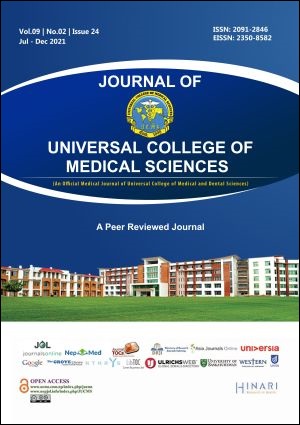Vitamin D Deficiency among Children with Sepsis in a Tertiary Care Center in Eastern Nepal
DOI:
https://doi.org/10.3126/jucms.v9i02.42004Keywords:
Children, Vitamin D deficiency, SepsisAbstract
INTRODUCTION: Vitamin D deficiency (VDD) is exceedingly predominant in children leading to dysregulation of the immune system and inflammation. Data on the prevalence of VDD in children with sepsis and its association with sepsis severity are limited from our part of the world. The primary aim of this study was to identify the burden of VDD in children with sepsis.
MATERIAL AND METHODS: One hundred and five children (< 15 years) with sepsis were enrolled from April 15, 2017 to April 14, 2018 from a tertiary care center in Eastern Nepal. Demographic data including BMI, sequential organ failure assessment (SOFA) scores were recorded at the time of admission. Plasma 25-hydroxy vitamin D [25(OH)D] levels were measured by chemiluminescence immunoassay technique (CLIA) (MAGLUMI 25-OH Vitamin D; CLIA) within 24 hours of admission. Vitamin D concentrations of <20 ng/mL (50 nmol/L) were considered as deficient.
RESULTS: Of the 105 children enrolled, the majority 74 (70.55%) had vitamin D deficiency. Vitamin D was deficient in 77, 65, and 66% of children in 1-5, 5-10, and 10-15 years of age group respectively. Vitamin D deficiency was maximum (80%) in underweight children. In the VDD group, 60% had severe sepsis, whereas only 32% had severe sepsis in vitamin D sufficient group with significant statistical association with sepsis severity and vitamin D deficiency.
CONCLUSION: A high burden of VDD is present in children with sepsis which was found to be associated with greater severity of illness.
Downloads
Downloads
Published
How to Cite
Issue
Section
License
Copyright (c) 2021 Journal of Universal College of Medical Sciences

This work is licensed under a Creative Commons Attribution-NonCommercial 4.0 International License.
Authors have to give the following undertakings along with their article:
- I/we declare that this article is original and has not been submitted to another journal for publication.
- I/we declare that I/we surrender all the rights to the editor of the journal and if published will be the property of the journal and we will not publish it anywhere else, in full or part, without the permission of the Chief Editor.
- Institutional ethical and research committee clearance certificate from the institution where work/research was done, is required to be submitted.
- Articles in the Journal are Open Access articles published under the Creative Commons CC BY-NC License (https://creativecommons.org/licenses/by-nc/4.0/)
- This license permits use, distribution and reproduction in any medium, provided the original work is properly cited, and it is not used for commercial purposes.




